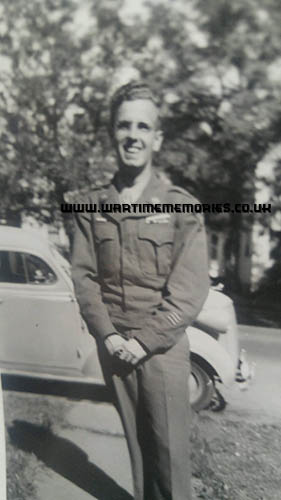|
|
|
Stalag 12A Prisoner of War Camp
Stalag 12A was one of Germany's largest prisoner of war camps and was located in Limburg, Germany.
22nd Jul 1941 Parcels
7th June 1944 Shot down over Brittany
If you can provide any additional information, please add it here.
|
|
|
The Wartime Memories Project is the original WW1 and WW2 commemoration website.
Announcements
- The Wartime Memories Project has been running for 24 years. If you would like to support us, a donation, no matter how small, would be much appreciated, annually we need to raise enough funds to pay for our web hosting and admin or this site will vanish from the web.
- 22nd April 2024 - Please note we currently have a huge backlog of submitted material, our volunteers are working through this as quickly as possible and all names, stories and photos will be added to the site. If you have already submitted a story to the site and your UID reference number is higher than 263973 your information is still in the queue, please do not resubmit, we are working through them as quickly as possible.
- Looking for help with Family History Research?
Please read our Family History FAQ's
- The free to access section of The Wartime Memories Project website is run by volunteers and funded by donations from our visitors. If the information here has been helpful or you have enjoyed reaching the stories please conside making a donation, no matter how small, would be much appreciated, annually we need to raise enough funds to pay for our web hosting or this site will vanish from the web.
If you enjoy this site
please consider making a donation.
Want to find out more about your relative's service? Want to know what life was like during the War? Our
Library contains an ever growing number diary entries, personal letters and other documents, most transcribed into plain text. |
|
We are now on Facebook. Like this page to receive our updates.
If you have a general question please post it on our Facebook page.
Wanted: Digital copies of Group photographs, Scrapbooks, Autograph books, photo albums, newspaper clippings, letters, postcards and ephemera relating to WW2. We would like to obtain digital copies of any documents or photographs relating to WW2 you may have at home. If you have any unwanted
photographs, documents or items from the First or Second World War, please do not destroy them.
The Wartime Memories Project will give them a good home and ensure that they are used for educational purposes. Please get in touch for the postal address, do not sent them to our PO Box as packages are not accepted.
World War 1 One ww1 wwII second 1939 1945 battalion
Did you know? We also have a section on The Great War. and a
Timecapsule to preserve stories from other conflicts for future generations.
|
|
Want to know more about Stalag 12A Prisoner of War Camp? There are:94 items tagged Stalag 12A Prisoner of War Camp available in our Library There are:94 items tagged Stalag 12A Prisoner of War Camp available in our Library 
These include information on officers, regimental histories, letters, diary entries, personal accounts and information about actions during the Second World War. |
|
Sargent Richard E Young 327 GIR Company G 101st Airborne My dad, Sgt. Richard E. Young of the 101st Airborne 327 GIR. Company G was captured at Marvie near Bastogne either the 23rd or 24th of December. I know he was taken to Limburg Germany but that is about all I can come up with. He was with Lieutenant Morrison at Hill 500 when he was captured late in the afternoon or evening. I am looking for the group of Germans who captured them. I think I can find out through the literature I have gathered. There are very few of his company left.
Has anyone heard of Hill 500? I would like to go to Germany someday and trace his footsteps as much as I can.
As far as information about Stalag 12a, I found information on my dad from the National Archives in Washington DC. The National Archives has since moved to Baltimore I believe.
My dad was also at Carantan with the 101st where they were in a heck of a fight. The Sargent was hit by a mortar and Dad took over.
I would like to know how and when my dad and the prisoners at Limburg in Stalag 12a were liberated.
|
Sargent Richard E Young 327 GIR Company G 101st Airborne My dad, Sgt. Richard E. Young of the 101st Airborne 327 GIR. Company G was captured at Marvie near Bastogne either the 23rd or 24th of December. I know he was taken to Limburg Germany but that is about all I can come up with. He was with Lieutenant Morrison at Hill 500 when he was captured late in the afternoon or evening. I am looking for the group of Germans who captured them. I think I can find out through the literature I have gathered. There are very few of his company left.
Has anyone heard of Hill 500? I would like to go to Germany someday and trace his footsteps as much as I can.
As far as information about Stalag 12a, I found information on my dad from the National Archives in Washington DC. The National Archives has since moved to Baltimore I believe.
My dad was also at Carantan with the 101st where they were in a heck of a fight. The Sargent was hit by a mortar and Dad took over.
I would like to know how and when my dad and the prisoners at Limburg in Stalag 12a were liberated.
|
Albert Edward Morgan Albert Edward Morgan was a POW in Stalag 12a; this is all the information we have. He did survive the war, but was divorced by my Grandmother due to his behaviour – this, we think, was due to what he went through in Stalag 12a and the war.
|
W/O L. W. C. Lewis 514 Sqd. W/O Lewis survived the loss of Lancaster DS822 JI-T when it came down at La Celle Le Bordes France on the 8th of June 1944 whilst on a bombing raid to Massy Palaiseau. He evaded capture until the 16th of August and was then taken to Stalag 12a and later to Stalag Luft 1.
|
PFC. Michael Louis Codian 28th Infantry Division Michael Codian was captured in the Huertgen Forest and spent the rest of the war in Stalags 12A and 9B Limburg An Der Lahn, Hessen-Nassau, Prussia.
|
Gordon L. Slater Gordon Slater joined the service planning to attend an Army Specified Training Program at a nearby college. Sudden cancellation of the program sent him to Fort Benning for training. He went overseas 6th of August 1944 finding himself on the front lines in France. Awful story short, he survived Stalag 12-A prison camp. He rarely spoke of his terrible experience.
|
Glenn Broin Knudson Glenn Knudson born 1913, my great uncle, was a POW in World War 2. I just found this out.
He was sent to Stalag 12A and then to Stalag 9B at Limburg An Der Lahn Hessen-Nassau, Prussia.
I think he was in the Navy, but I'm not sure.
He died in 1992.
|
S/Sgt. Louis Nick Saites BSM Co. B, 1st Btn. 10th Infantry Regiment 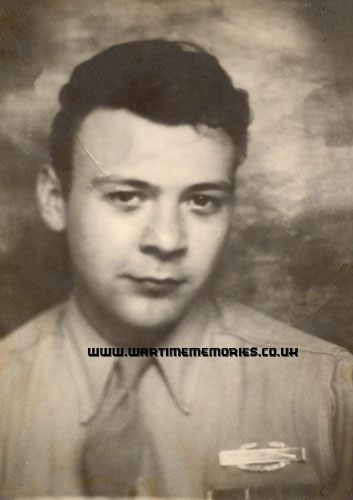 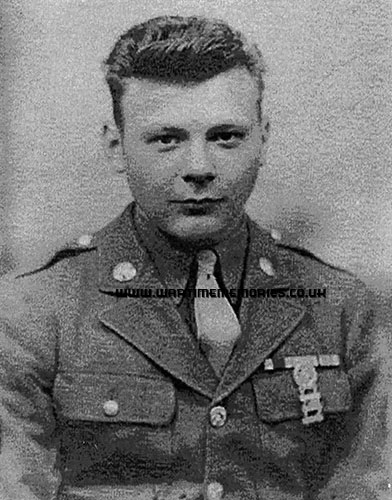 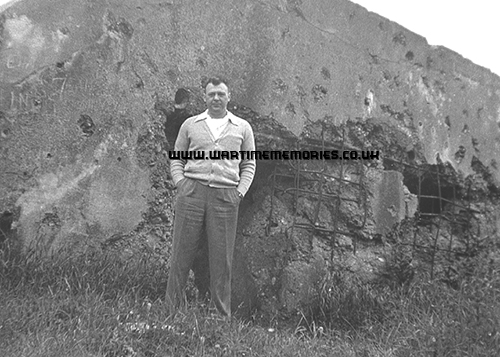 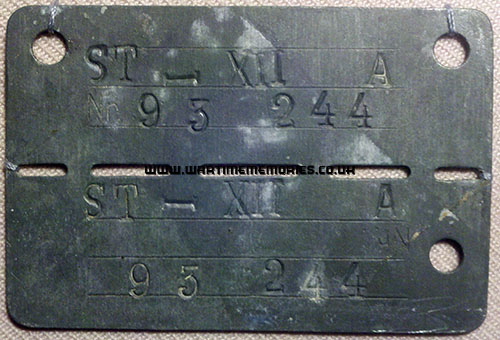 Thirteen months before Pearl Harbor was attacked, my father Louis Saites joined the Army at the age of sixteen. Life at home was not always easy and that prompted Louis to join the Army. He didn’t have his father’s permission, which was required, so he lied about his age. He needed proof of age and he offered his Greek baptismal certificate, which he had altered. He changed his birth year to make himself two years older. Despite the poor job he did in amending the date, the Army accepted it. So at sixteen, he was a private in the United States Army assigned to the 5th Infantry Division, 2nd Infantry Regiment, 2nd Battalion, Co. G.
Louis was 18 when he was assigned to an intelligence unit in Reykjavik, Iceland. He arrived on 16th of September 1941. His job in intelligence was to befriend and get close to Icelandic persons who were suspected of spying for the Germans. Investigating one specific suspect proved very difficult. Louis went to great lengths to discover what he could about the man's activities, even dating the man's daughter while trying to gain entrance to their house. When he was still unable to get into the house, Louis decided to marry the daughter. Finally gaining entrance to the suspect's home, Louis was able to confirm the man was indeed aiding the Germans as a spy.
On 20 August 1942, Louis was reassigned to the 5th Infantry Division, 10th Infantry Regiment, 1st Battalion, Co. B and remained in intelligence. The 5th Division was transferred to the European Theater, and his military records show that he arrived in England on 8th of August 1943.
In England and later North Ireland, his work in intelligence was searching for German sympathizers among his fellow soldiers. He felt good that none was ever found. During the two years he was in Great Britain, he also participated in infantry training as the U.S. and the British prepared for the D-Day invasion.
The 5th Infantry Division landed in Normandy on Utah Beach on 10th of July 1944. Over the next several weeks, the 5th Division participated in numerous successful attacks, advancing from Normandy to Reims and seizing the city on 30 August 1944. The last battle that Louis fought in was the Battle of Fort Driant. It was during the Battle of Fort Driant that Louis, now a 20-year old staff sergeant, was captured on 7th of October 1944. He had been wounded and had shrapnel in his leg when he took refuge with a group of fellow soldiers. They were hiding in a small bunker built into the side of a mound of earth when they were overtaken by a tank command and forced to surrender.
As a prisoner of war, Louis was initially processed at Stalag XII-A in Limburg, Germany. He was interrogated and assigned prisoner number 93244. It wasn’t long before he was shipped by train to Stalag III-C in Alt-Drewitz, Brandenburg, Prussia, now Poland. They travelled in cattle cars that were so full they were all forced to stand the entire way. Life at Stalag III-C was a very difficult experience. It was at this camp that he was not only interrogated but also tortured. Conditions at the prison were very bad. They had little to eat, and what food they did get was awful. They ate weeds, bugs, and mice to augment their diet. Housing was in wooden buildings with very little heat and they were given only one blanket for protection against the harsh winter. After several months of internment, the prisoners learned the Soviet Army was approaching and the Germans were planning to move the prisoners towards Berlin.
On the 30th or 31st of January 1945, the Russian Army was nearing the prison camp and the Germans forced the prisoners out of the camp. They were on a forced march when they were suddenly fired upon by the Russians. Louis and another man were near the end of the line of prisoners and took advantage of the chaos to run into the woods. They were able to make their way to a farm and the Polish farmer gave them a couple of bicycles. Travelling away from the camp, they finally met up with the Russian Army and travelled with them to Odessa. After a long period of travelling from Odessa to Egypt, to Malta, to France, and then to Naples, Italy, he was finally sent home.
His military records note that he participated in three European Campaigns: Normandy, North France, and Rhineland. He also received his first Combat Infantry Badge. After a 59-day furlough at home in Lansing, Michigan, he returned to duty and was honorably discharged on 10 July 1945. He reenlisted on 10th June 1946 and remained in the Army until retiring in 1962.
During his service Louis earned the following: Bronze Star, Purple Heart, Air Medal, Army Commendation Medal with Oak Leaf Cluster, Army Presidential Unit Citation (2), Prisoner of War Medal, Army Good Conduct Medal, American Defense Service Medal, American Campaign Medal, Europe/African/Middle Eastern Campaign Medal with 3 Bronze Battle Stars, World War II Victory Medal, Army of Occupation Medal 1945-1990, National Defense Service Medal, Korea Service Medal with 2 Bronze Service Stars, Armed Forces Reserve Medal, and United Nations Service Medal. In addition, he received two Combat Infantry Badges and eight Overseas Bars.
|
Gnr. Leslie Newham 1st Air Landing Regiment Royal Artillery My uncle, Leslie Newham, was one of the first soldiers to land in Arnhem in Sept 1944. Unfortuntely, he was captured by the Germans on 26th of September 1944 and taken to a German P.O.W camp.
He was initially taken to Stalag 12A & was then transferred to Stalag 4B. He was being transferred again on 28 Jan & was marching westwards when he was released on 30 Jan 1945 when the Soviet Red Army liberated the camps.
|
Pte. Tom Swinburne "Bud" Abbott Airborne Signals 1st Parachute Brigade Tom Abbott was my dad.
He was 21 when captured in Arnhem and sent to a POW camp in Limburg, Germany. He escaped with a Canadian fellow inmate from a working party repairing the railway marshalling yards after an RAF raid. When recaptured, they were found to have pureed apples and margarine in their pockets that they had found in a railway wagon. Because they had food on them they were accused of looting, and a formal request to execute them was made. The permission to execute was granted, but before the sentence was carried out the camp was bombed on Christmas Eve and Dad survived because they were being held in an underground cell. The Germans demanded that everybody with carpentry knowledge help rebuild the huts. Dad immediately claimed to be a carpenter (he was actually a glassblower), and in the ensuing mayhem he and his Canadian buddy were able to get into the Disciplinary Officer's hut and destroy the order to execute.
Shortly afterwards, they were sent to a POW camp in Bad Orb where he remained until liberated by the Americans. Dad’s overriding memory of Bad Orb was arriving after being marched there from Limburg to hear gunfire coming from the surrounding woodland. On inquiring what was happening, they were told that in order to make room for them the Russians that had previously been prisoners there were being shot because the Germans had no room for them, and Russia had not signed the Geneva Convention.
|
A/Cpl. Charles Birrell 8th Btn. Scots Guards My dad, Charles Birrell, hailed from Forgan in Fife.
On researching him I found out he joined the 8th Battalion, Scots Guards which became part of the 44th Lowland Infantry Brigade and were involved in Operation Overlord, the Battle of Caen, Operation Epsom, second Battle of the Odon, and Operation Bluecoat between June 1944 and August 1944. They then fought in the Northwest Europe Campaign (Siegfried Line Campaign) during which my father was captured in Belgium by the Germans in September 1944.
He wouldn't tell us much about his time during the war or his time in Stalag XII-A but he suffered with his stomach and bowel for years. He did tell us that the men had to forage the rubbish for food and would make soup from potato peelings. He mentioned being liberated by the Americans and said he was glad that it wasn't the Russians, but I don't know why this was. I still have the letter sent to his mother that said he was missing and presumed dead.
|
PFC. Robert Loraine "Lee" Schlegel My father Robert Schlegel was a POW in Germany, in Stalag XIIA. I have my father's ID card or processing card. Given the very good condition of the card, I would suspect it was issued at the time of repatriation from the POW camp when he was reconnected with US Forces. The Allied Forces and the Russians were both closing in on the area, and the German guards tried to turn themselves over to the US prisoners knowing they would be treated fairly. They were afraid the Russians would get there first and they knew they wouldn't fare well with the Russian troops. In the end they all scattered, hiding from any lingering SS troops that were still in the area, and waited for the Allied troops to arrive. I have a good account of that time from the stories my father wrote down. On the back of the card is the name of someone who I assume was another POW, Joseph A. Wilbur from Jamestown, NY.
|
Pte. Thomas Whittaker 10th (Parachute) Btn. South Lancashire Regiment
I recently found out through a cutting taken from the Warrington Guardian that my father, Thomas Whittaker, who was a paratrooper during WW2 and was taken prisoner next to the railway lines in Nijmegen near Arnhem, was taken to Stalag 12a near Limburg an der Lahn, Germany. The report from the Guardian says my father sent a letter to his mother stating that he was alive and well but not to reply due to him being moved to another camp. I know he was then moved to Stalag 4b, where he remained until he was liberated by the Russians and returned home to England. None of us know how long he stayed at Stalag 12a, maybe a night, maybe weeks or months. I have looked up Stalag 4b and know it's near Mulhberg in what was East Germany. My grandmother had another son in service missing at the time, Harry Whittaker, who was with the Chindits in Burma. Fortunately, both sons returned home safely.
|
PFC. Robert G. Vial 1st Infantry My Uncle Bob Vial was a POW at Stalag 12A and 9B from 23rd of November 1944 until liberated by the Russians. The Russians saw, and stole his wristwatch when he was being liberated. He also had mentioned his wound was itching so he unwrapped his bandage to discover there was a spider under it.
|
Pte. Arthur William James 1st Btn. North Staffordshire Regiment 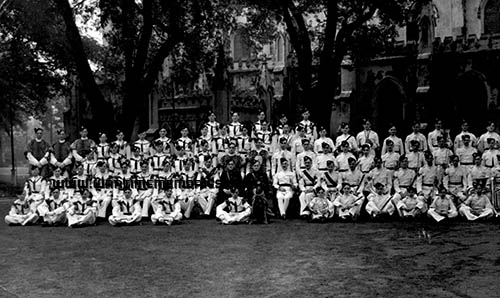 Arthur James, then aged 19 years, enlisted with the Regular Army in Stoke-On-Trent on 31st of March 1933 for 7 years with the Colours & 5 years in the Reserve.
He became an Army medic with 1st Battalion, North Staffordshire Regiment for 13 years between 1933 and 1946. He served 8 and a half years in Poona (Pune), India as a Private (and musician with the battalion's marching band) during peace time.
Arthur was recorded as missing in action on 8th of August 1944, the day before his eldest son was born. He had been captured in Normandy to become an Allied Prisoner of War and was held in Stalag XII-A at Limburg an der Lahn, north-west of Frankfurt, Germany. Later, he was moved south to Stalag VII-A at Moosburg, near Freising, north-east of Munich, Germany and was among those liberated on 29th of April 1945 by American forces (Combat Command A of the American 14th Armored Division).
Arthur was awarded the War Medal 1939-45, France and Germany Star and Burma Star Medals. He came out of the Regular Army on 4th of March 1946 and
transferred to the Army Reserve on 5th of March 1946, aged 32 years.
|
Sargent Richard E Young 327 GIR Company G 101st Airborne My dad, Sgt. Richard E. Young of the 101st Airborne 327 GIR. Company G was captured at Marvie near Bastogne either the 23rd or 24th of December. I know he was taken to Limburg Germany but that is about all I can come up with. He was with Lieutenant Morrison at Hill 500 when he was captured late in the afternoon or evening. I am looking for the group of Germans who captured them. I think I can find out through the literature I have gathered. There are very few of his company left.
Has anyone heard of Hill 500? I would like to go to Germany someday and trace his footsteps as much as I can.
As far as information about Stalag 12a, I found information on my dad from the National Archives in Washington DC. The National Archives has since moved to Baltimore I believe.
My dad was also at Carantan with the 101st where they were in a heck of a fight. The Sargent was hit by a mortar and Dad took over.
I would like to know how and when my dad and the prisoners at Limburg in Stalag 12a were liberated.
|
Sargent Richard E Young 327 GIR Company G 101st Airborne My dad, Sgt. Richard E. Young of the 101st Airborne 327 GIR. Company G was captured at Marvie near Bastogne either the 23rd or 24th of December. I know he was taken to Limburg Germany but that is about all I can come up with. He was with Lieutenant Morrison at Hill 500 when he was captured late in the afternoon or evening. I am looking for the group of Germans who captured them. I think I can find out through the literature I have gathered. There are very few of his company left.
Has anyone heard of Hill 500? I would like to go to Germany someday and trace his footsteps as much as I can.
As far as information about Stalag 12a, I found information on my dad from the National Archives in Washington DC. The National Archives has since moved to Baltimore I believe.
My dad was also at Carantan with the 101st where they were in a heck of a fight. The Sargent was hit by a mortar and Dad took over.
I would like to know how and when my dad and the prisoners at Limburg in Stalag 12a were liberated.
|
Albert Edward Morgan Albert Edward Morgan was a POW in Stalag 12a; this is all the information we have. He did survive the war, but was divorced by my Grandmother due to his behaviour – this, we think, was due to what he went through in Stalag 12a and the war.
|
W/O L. W. C. Lewis 514 Sqd. W/O Lewis survived the loss of Lancaster DS822 JI-T when it came down at La Celle Le Bordes France on the 8th of June 1944 whilst on a bombing raid to Massy Palaiseau. He evaded capture until the 16th of August and was then taken to Stalag 12a and later to Stalag Luft 1.
|
PFC. Michael Louis Codian 28th Infantry Division Michael Codian was captured in the Huertgen Forest and spent the rest of the war in Stalags 12A and 9B Limburg An Der Lahn, Hessen-Nassau, Prussia.
|
Gordon L. Slater Gordon Slater joined the service planning to attend an Army Specified Training Program at a nearby college. Sudden cancellation of the program sent him to Fort Benning for training. He went overseas 6th of August 1944 finding himself on the front lines in France. Awful story short, he survived Stalag 12-A prison camp. He rarely spoke of his terrible experience.
|
Glenn Broin Knudson Glenn Knudson born 1913, my great uncle, was a POW in World War 2. I just found this out.
He was sent to Stalag 12A and then to Stalag 9B at Limburg An Der Lahn Hessen-Nassau, Prussia.
I think he was in the Navy, but I'm not sure.
He died in 1992.
|
S/Sgt. Louis Nick Saites BSM Co. B, 1st Btn. 10th Infantry Regiment     Thirteen months before Pearl Harbor was attacked, my father Louis Saites joined the Army at the age of sixteen. Life at home was not always easy and that prompted Louis to join the Army. He didn’t have his father’s permission, which was required, so he lied about his age. He needed proof of age and he offered his Greek baptismal certificate, which he had altered. He changed his birth year to make himself two years older. Despite the poor job he did in amending the date, the Army accepted it. So at sixteen, he was a private in the United States Army assigned to the 5th Infantry Division, 2nd Infantry Regiment, 2nd Battalion, Co. G.
Louis was 18 when he was assigned to an intelligence unit in Reykjavik, Iceland. He arrived on 16th of September 1941. His job in intelligence was to befriend and get close to Icelandic persons who were suspected of spying for the Germans. Investigating one specific suspect proved very difficult. Louis went to great lengths to discover what he could about the man's activities, even dating the man's daughter while trying to gain entrance to their house. When he was still unable to get into the house, Louis decided to marry the daughter. Finally gaining entrance to the suspect's home, Louis was able to confirm the man was indeed aiding the Germans as a spy.
On 20 August 1942, Louis was reassigned to the 5th Infantry Division, 10th Infantry Regiment, 1st Battalion, Co. B and remained in intelligence. The 5th Division was transferred to the European Theater, and his military records show that he arrived in England on 8th of August 1943.
In England and later North Ireland, his work in intelligence was searching for German sympathizers among his fellow soldiers. He felt good that none was ever found. During the two years he was in Great Britain, he also participated in infantry training as the U.S. and the British prepared for the D-Day invasion.
The 5th Infantry Division landed in Normandy on Utah Beach on 10th of July 1944. Over the next several weeks, the 5th Division participated in numerous successful attacks, advancing from Normandy to Reims and seizing the city on 30 August 1944. The last battle that Louis fought in was the Battle of Fort Driant. It was during the Battle of Fort Driant that Louis, now a 20-year old staff sergeant, was captured on 7th of October 1944. He had been wounded and had shrapnel in his leg when he took refuge with a group of fellow soldiers. They were hiding in a small bunker built into the side of a mound of earth when they were overtaken by a tank command and forced to surrender.
As a prisoner of war, Louis was initially processed at Stalag XII-A in Limburg, Germany. He was interrogated and assigned prisoner number 93244. It wasn’t long before he was shipped by train to Stalag III-C in Alt-Drewitz, Brandenburg, Prussia, now Poland. They travelled in cattle cars that were so full they were all forced to stand the entire way. Life at Stalag III-C was a very difficult experience. It was at this camp that he was not only interrogated but also tortured. Conditions at the prison were very bad. They had little to eat, and what food they did get was awful. They ate weeds, bugs, and mice to augment their diet. Housing was in wooden buildings with very little heat and they were given only one blanket for protection against the harsh winter. After several months of internment, the prisoners learned the Soviet Army was approaching and the Germans were planning to move the prisoners towards Berlin.
On the 30th or 31st of January 1945, the Russian Army was nearing the prison camp and the Germans forced the prisoners out of the camp. They were on a forced march when they were suddenly fired upon by the Russians. Louis and another man were near the end of the line of prisoners and took advantage of the chaos to run into the woods. They were able to make their way to a farm and the Polish farmer gave them a couple of bicycles. Travelling away from the camp, they finally met up with the Russian Army and travelled with them to Odessa. After a long period of travelling from Odessa to Egypt, to Malta, to France, and then to Naples, Italy, he was finally sent home.
His military records note that he participated in three European Campaigns: Normandy, North France, and Rhineland. He also received his first Combat Infantry Badge. After a 59-day furlough at home in Lansing, Michigan, he returned to duty and was honorably discharged on 10 July 1945. He reenlisted on 10th June 1946 and remained in the Army until retiring in 1962.
During his service Louis earned the following: Bronze Star, Purple Heart, Air Medal, Army Commendation Medal with Oak Leaf Cluster, Army Presidential Unit Citation (2), Prisoner of War Medal, Army Good Conduct Medal, American Defense Service Medal, American Campaign Medal, Europe/African/Middle Eastern Campaign Medal with 3 Bronze Battle Stars, World War II Victory Medal, Army of Occupation Medal 1945-1990, National Defense Service Medal, Korea Service Medal with 2 Bronze Service Stars, Armed Forces Reserve Medal, and United Nations Service Medal. In addition, he received two Combat Infantry Badges and eight Overseas Bars.
|
Gnr. Leslie Newham 1st Air Landing Regiment Royal Artillery My uncle, Leslie Newham, was one of the first soldiers to land in Arnhem in Sept 1944. Unfortuntely, he was captured by the Germans on 26th of September 1944 and taken to a German P.O.W camp.
He was initially taken to Stalag 12A & was then transferred to Stalag 4B. He was being transferred again on 28 Jan & was marching westwards when he was released on 30 Jan 1945 when the Soviet Red Army liberated the camps.
|
Pte. Tom Swinburne "Bud" Abbott Airborne Signals 1st Parachute Brigade Tom Abbott was my dad.
He was 21 when captured in Arnhem and sent to a POW camp in Limburg, Germany. He escaped with a Canadian fellow inmate from a working party repairing the railway marshalling yards after an RAF raid. When recaptured, they were found to have pureed apples and margarine in their pockets that they had found in a railway wagon. Because they had food on them they were accused of looting, and a formal request to execute them was made. The permission to execute was granted, but before the sentence was carried out the camp was bombed on Christmas Eve and Dad survived because they were being held in an underground cell. The Germans demanded that everybody with carpentry knowledge help rebuild the huts. Dad immediately claimed to be a carpenter (he was actually a glassblower), and in the ensuing mayhem he and his Canadian buddy were able to get into the Disciplinary Officer's hut and destroy the order to execute.
Shortly afterwards, they were sent to a POW camp in Bad Orb where he remained until liberated by the Americans. Dad’s overriding memory of Bad Orb was arriving after being marched there from Limburg to hear gunfire coming from the surrounding woodland. On inquiring what was happening, they were told that in order to make room for them the Russians that had previously been prisoners there were being shot because the Germans had no room for them, and Russia had not signed the Geneva Convention.
|
A/Cpl. Charles Birrell 8th Btn. Scots Guards My dad, Charles Birrell, hailed from Forgan in Fife.
On researching him I found out he joined the 8th Battalion, Scots Guards which became part of the 44th Lowland Infantry Brigade and were involved in Operation Overlord, the Battle of Caen, Operation Epsom, second Battle of the Odon, and Operation Bluecoat between June 1944 and August 1944. They then fought in the Northwest Europe Campaign (Siegfried Line Campaign) during which my father was captured in Belgium by the Germans in September 1944.
He wouldn't tell us much about his time during the war or his time in Stalag XII-A but he suffered with his stomach and bowel for years. He did tell us that the men had to forage the rubbish for food and would make soup from potato peelings. He mentioned being liberated by the Americans and said he was glad that it wasn't the Russians, but I don't know why this was. I still have the letter sent to his mother that said he was missing and presumed dead.
|
PFC. Robert Loraine "Lee" Schlegel My father Robert Schlegel was a POW in Germany, in Stalag XIIA. I have my father's ID card or processing card. Given the very good condition of the card, I would suspect it was issued at the time of repatriation from the POW camp when he was reconnected with US Forces. The Allied Forces and the Russians were both closing in on the area, and the German guards tried to turn themselves over to the US prisoners knowing they would be treated fairly. They were afraid the Russians would get there first and they knew they wouldn't fare well with the Russian troops. In the end they all scattered, hiding from any lingering SS troops that were still in the area, and waited for the Allied troops to arrive. I have a good account of that time from the stories my father wrote down. On the back of the card is the name of someone who I assume was another POW, Joseph A. Wilbur from Jamestown, NY.
|
Pte. Thomas Whittaker 10th (Parachute) Btn. South Lancashire Regiment
I recently found out through a cutting taken from the Warrington Guardian that my father, Thomas Whittaker, who was a paratrooper during WW2 and was taken prisoner next to the railway lines in Nijmegen near Arnhem, was taken to Stalag 12a near Limburg an der Lahn, Germany. The report from the Guardian says my father sent a letter to his mother stating that he was alive and well but not to reply due to him being moved to another camp. I know he was then moved to Stalag 4b, where he remained until he was liberated by the Russians and returned home to England. None of us know how long he stayed at Stalag 12a, maybe a night, maybe weeks or months. I have looked up Stalag 4b and know it's near Mulhberg in what was East Germany. My grandmother had another son in service missing at the time, Harry Whittaker, who was with the Chindits in Burma. Fortunately, both sons returned home safely.
|
PFC. Robert G. Vial 1st Infantry My Uncle Bob Vial was a POW at Stalag 12A and 9B from 23rd of November 1944 until liberated by the Russians. The Russians saw, and stole his wristwatch when he was being liberated. He also had mentioned his wound was itching so he unwrapped his bandage to discover there was a spider under it.
|
Pte. Arthur William James 1st Btn. North Staffordshire Regiment  Arthur James, then aged 19 years, enlisted with the Regular Army in Stoke-On-Trent on 31st of March 1933 for 7 years with the Colours & 5 years in the Reserve.
He became an Army medic with 1st Battalion, North Staffordshire Regiment for 13 years between 1933 and 1946. He served 8 and a half years in Poona (Pune), India as a Private (and musician with the battalion's marching band) during peace time.
Arthur was recorded as missing in action on 8th of August 1944, the day before his eldest son was born. He had been captured in Normandy to become an Allied Prisoner of War and was held in Stalag XII-A at Limburg an der Lahn, north-west of Frankfurt, Germany. Later, he was moved south to Stalag VII-A at Moosburg, near Freising, north-east of Munich, Germany and was among those liberated on 29th of April 1945 by American forces (Combat Command A of the American 14th Armored Division).
Arthur was awarded the War Medal 1939-45, France and Germany Star and Burma Star Medals. He came out of the Regular Army on 4th of March 1946 and
transferred to the Army Reserve on 5th of March 1946, aged 32 years.
|
Recomended Reading.Available at discounted prices.
|
The Last Escape. The Untold Story of Allied Prisoners of War in Germany 1944-45John Nichol & Tony Rennell
As WW2 drew to a close, hundreds of thousands of British and American prisoners of war, held in camps in Nazi-occupied Europe, faced the prospect that they would never get home alive. In the depths of winter, their guards harried them on marches outof their camps and away from the armies advancing into the heart of Hitler's defeated Germany. Hundreds died from exhaustion, disease and starvation. The Last Escape is told through the testimony of those heroic men, now in their seventies and eighties and telling their stories publicly for the first time.
A very good account of a forgotten part of the Second World War; Allied POW's caught in the final months of the Third Reich. The author's of this book have provide the reader with a detailed and moving account of what happened to the many thousands of Allied POW's caught in the final struggle for Nazi Germany towards the end of WW2.
|
|
|




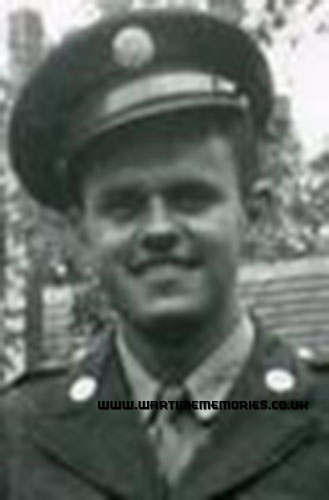
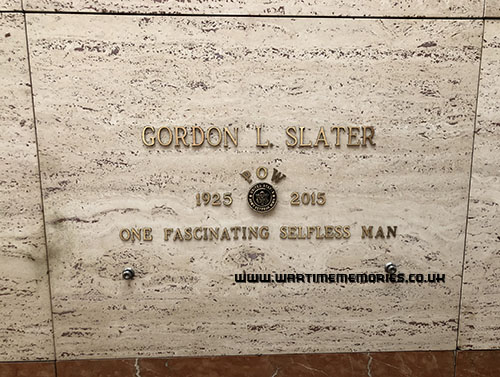




.jpg)
.jpg)
